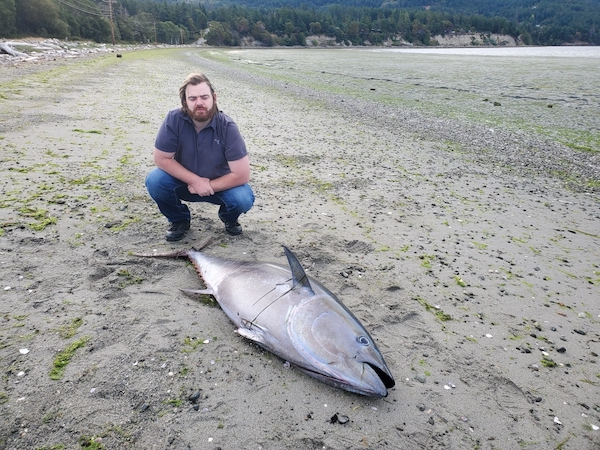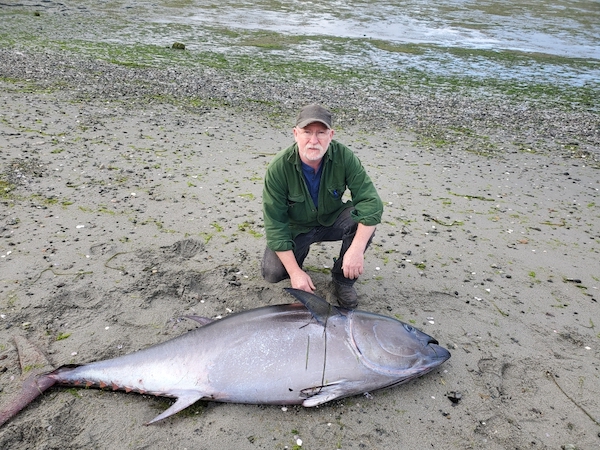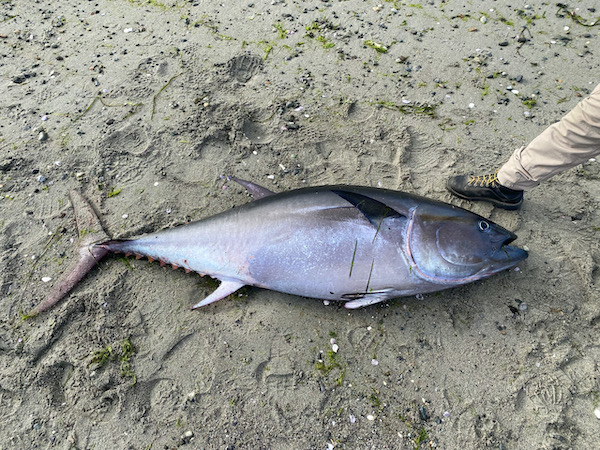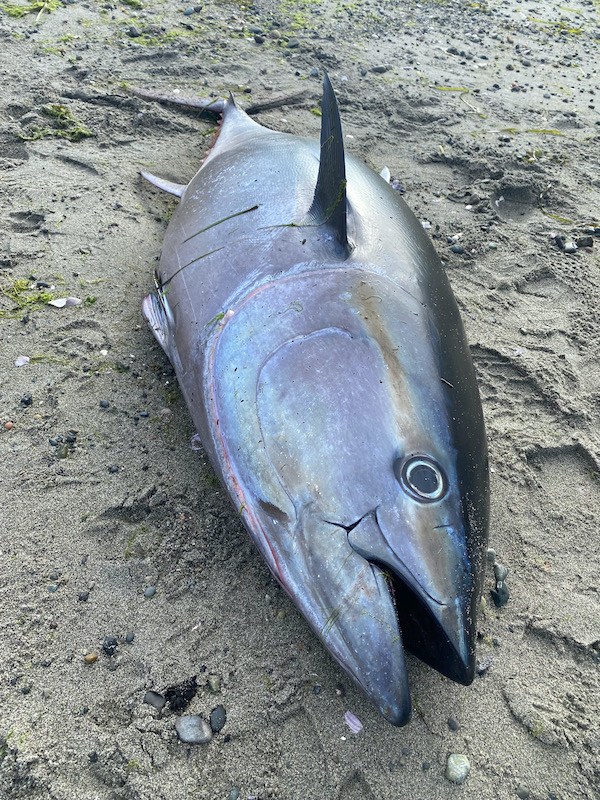
Bluefin Tuna Washes Up On Orcas Island’s East Sound
Editor’s note: Updated at 9:15 p.m., July 11, 2023, at bottom with thoughts from a Washington Coast tuna skipper.
Orcas Island is known for odd visitors from the wildlife world – a pair of bull elk, a bear – but what apparently washed ashore overnight may take the cake.
A large Pacific bluefin tuna, an open-ocean species that is far, far, far more common in California’s offshore waters than the San Juan Islands.

Northwest Sportsman source and local landowner Gary Lundquist and his youngest son JD were headed to the ferry dock early this morning when they spotted a lump on Crescent Beach by the village of Eastsound and went to investigate.
“We saw it first thing. There was only one other set of tracks on the beach. It’s probably 5-foot, 60-something inches,” he said.
Crescent Beach lies at the top end of East Sound, a narrow inlet stretching from the heart of the San Juans past Olga and Rosario.
Lundquist described the fish as untouched, so it was likely deposited – or stranded – by last night’s midnight 8-foot-or-so high tide. This morning’s low was at 7:28 at nearby Friday Harbor on San Juan Island.
Northwest tuna fishing is dominated by albacore – the first sport-caught ones of the season were landed this week – but bluefin occasionally are caught. The state record bluefin is a 92.15-pounder caught off Ilwaco in 2019.
“I thought about throwing it in my truck,” Lundquist said, but ultimately didn’t, recalling episodes of Wicked Tuna that suggest that even if the exterior of a tuna looks good, the insides can go bad.
He said that as a kid in the San Juans, he recalled finding a washed up 5- or 6-foot shark that had had its tail cut off, but nothing ever like a bluefin here before.
Lundquist and his son had just finished cutting their hay yesterday and were running home today to grab their boat when they spotted the bluefin on the beach.
“I’ll start raking hay tomorrow keeping an eye out for zebras and giraffes,” he joked Tuesday evening.

After the Lundquists headed for the ferry, the bluefin was collected by SeaDoc Society researchers for sampling and it was taken to the University of Washington’s Friday Harbor Labs where it will be dissected in the coming weeks, according to the society’s Joe Gaydos. He said the exam should help shed light on how the tuna died and came to be stranded on Crescent Beach.
“Right now, I can only say there didn’t appear to be any signs of trauma from net entanglement, nothing in the mouth like an old hook, but other than that, the animal was in good nutritional condition – really a beautiful specimen!” said Gaydos.

He said that bluefin tuna have never been seen in the Salish Sea, per a complete list of all the fish species that occur in these sheltered inside saltwaters – and he found it ironic that one should happen to turn up on the same day as the book A Field Guide to Fishes of the Salish Sea was published. Needless to say, it does not list Thunnus orientalis.
(In another oddity, earlier this summer a Humboldt squid washed up on a Whidbey Island beach near Freeland.)
But a 2014 paper by a Canadian grad student detailing an indigenous midden on the west coast of Vancouver Island does mention finding bluefin bones there and states the species “was present nearshore in the past, and could be harpooned as it fed at the ocean’s surface at night.”
A 1997 fishery bulletin fleshes that out more, stating that vertebrae of bluefin estimated to have been 3 1/2 to 8 feet long and weighing from 103 to 645 pounds were found at native sites from Cape Flattery on Washington’s North Coast to Barkley and Nootka Sounds on the west coast of Vancouver Island to the Queen Charlottes, or Haida Gwaii.
Those are all ocean-facing locations and Orcas Island’s East Sound is tucked well up inside the San Juans archipelago, but it does get curiouser.
“The month of August is said to have been the time when tuna could be found feeding at the surface in inshore waters … The occurrences of large tuna were apparently preceded and accompanied by recognizable changes in water and weather conditions and by a unique set of associated fauna. Tuna traveled well inside Nootka Sound into protected inlets and were harpooned at night as they fed at the surface in shallow inshore waters (located by spotters positioned on nearby cliffs). Bioluminescent plankton present in the water made the big fish especially visible at night, even from a distance,” Susan Janet Crockford of Victoria wrote in the bulletin prepared for the National Marine Fisheries Service.
A technique known as “pit-lamping” – lighting a fire in a canoe – was also used to attract the fish, as was paddling away from them through the bioluminescent organisms so as to heave a harpoon as the tuna emerged at the head of the craft.
Crockford states that the recovery of tuna bones in archaeological deposits spanning nearly 5,000 years “is evidence that the occurrence of adult bluefin off the British Columbia coast was longstanding … The Nuu-chah-nulth people, in particular, were especially adept at using this resource, and their material culture included large seagoing canoes, detachable harpoon heads, braided ropes and floats required for the successful hunting of both whales and large tuna.”
She adds that the way bluefin feed at the surface “make them very conspicuous in inshore waters” and therefore “it would be extremely unlikely for adult tuna to go totally unnoticed for the last 100 years in British Columbia waters … It seems reasonable to assume under the circumstances that modern records are correct: large bluefin tuna have not frequented the northern waters of the eastern Pacific during the last 100 years. The reasons for their absence, however, remain to be determined.”
Pacific bluefin tuna declined for decades due to overfishing, reaching a “historically low level in 2010,” according to the International Scientific Committee for Tuna and Tuna-like Species in the North Pacific Ocean, but since then they have rebounded and are exceeding stock rebuilding goals, according to a 2022 assessment.
Whether it’s that recovery or the vagaries of longterm Pacific Ocean cycles once known to Northwest Coast natives or the nearshore nighttime hunting behavior of bluefins, or all of them or something entirely different, one turned up today in a very, very unusual location.
A number of other pics of the tuna were posted after the carcass was taken to Friday Harbor Labs and all of it is sparking conversation and questions about how the fish could have arrived in the San Juan Islands.
“My guess, if this isn’t a hoax, is that it was lost and died in the shallows due to cold water temperatures,” says Captain Mark Coleman of All Rivers and Saltwater Charters, full disclosure, a Northwest Sportsman advertiser. He runs express albacore tuna trips and fishes commercially for them out of Westport, as well as fishes for yellowfin in Costa Rica, so he knows his way around a number of pelagic species.
“Tuna are known to swim close to the surface in these scenarios. I rule out the fact that it was a commercial-caught fish because it hasn’t been frozen. You can tell that because the eyes are perfect. A fish that’s been frozen will have obvious opaque eyes, white eyes. I don’t think it was sport caught and released on that beach as a hoax either because there aren’t any line marks on the gill plates. After a lot of consideration I think it was a lost, cold tuna that died right at the reach of tide,” Coleman says.
“Very bizarre,” he adds.
Indeed, it all seems like Jim Lynch’s novel The Highest Tide come to life, except at the other end of Puget Sound and with a whole different pelagic species.
For now it’s an enigma.


